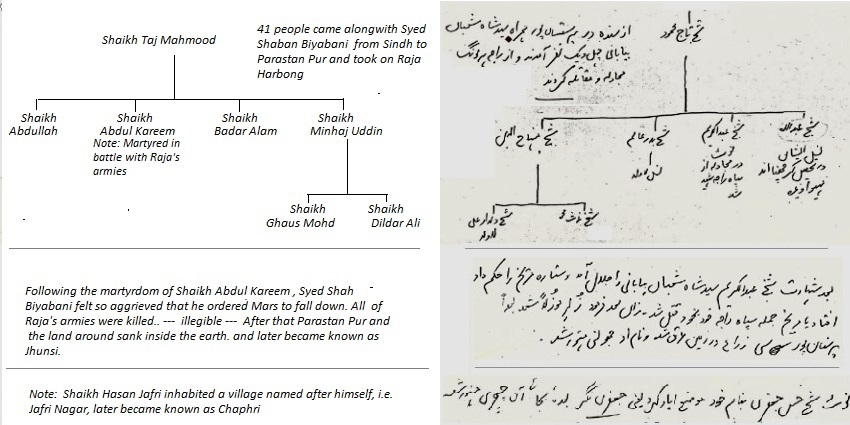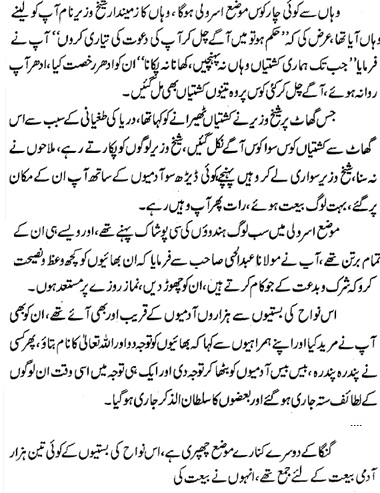
Copy of select parts of the old documents in Persian. Translation on the left.

We introduced our forefathers, the Shaikh clan, in the section 'Our Story' of the Introduction page. The name 'Shaikh' was not in common use after the the first few generations after the arrival of the clan in the Prayag/Allahabad area. However, there was at least one family branch where we see the name Shaikh used until around 19th century followed by a transition to the use of Ahmed/Ahmad as the surname. It was much later, around 1920’s, when we see the adoption of the surname Siddiqui begin. We researched the geneses of both of these surnames Siddiqui and Ahmad - names which imply a lineage of Arab origins.
Most shajras or family trees attempt to establish connections to past figures of fame, fortune, or nobility to hype their origins. Here we will make no effort to do so, but present data as we have found in our research. Regardless of whatever we call ourselves we are immensely proud of who and what we are. Interestingly, some branches of our family have been referred to by the locals as 'Gaddi' which is supposedly a derogating term but we, the principal authors of these pages, accept and cherish the label with joy and pride. Our own enthusiasm has, however, to be contained in deference to the sensitivities of other family members.
In tracing the origin of the name 'Siddiqui' in our family, we relied on a a set of hand-written documents written in Persian language and handed down generation-to-generation to members of the Chaphri branch of our family. Copies of our set of documents came from late Saghir Uddin of Chaphri who had inherited them from his grandfather. The entire document has been presented on our Persian Document page. Shown below are Shaikh Taj Mahmood's family and the 3 notes scribbled on the document, along with an English translation. The original translation from Persian to Urdu had been made by late Dr Rizwan Uddin Ahmad during 1980's.

Copy of select parts of the old documents in Persian. Translation on the left.
Our forefather Shaikh Minhaj Uddin was one of the brothers of Shaikh Abdul Karim who had been killed in the Parastan Pur battle with raja Harbong. We related the story in 'Our Story' section of our Home page. Shaikh Abdul Karim and his three brothers had been part of the group that had migrated from the west to the Prayag area.
The hand-written Persian document shows Shaikh Taj Mahmood as being the father of these 4 brothers. There are other parts of the notes that trace the lineage of Shaikh Taj Mahmood and show him as being the 11th generation descendant of Hazrat Abu Bakr Siddiq, the first Caliph who lived from 573 AD to 634 AD. The Parastan Pur battle is said to have taken place in 1359 AD when his son Shaikh Abdul Karim lost his life. Approximate calculations indicate that a period of nearly 650 years elapsed between Hazrat Abu Bakr Siddiq's generation and that of Shaikh Taj Mahmood, coming to an average 56 years' span between generation. According to anthropologists, 30 to 35 years' period between generations may normally be used, and 56 years' generational span is a big stretch, not entirely impossible but quite far-fetched.
There are two explanations for this inconsistency. First, it is entirely possible that the scriber of the document may have erred and omitted several generations. Second, the authenticity of the document itself could be questionable. These papers have been handed down purportedly having been originally written centuries ago during early Mughal era. An examination of the Persian text reveals the use of the English word 'Note' (transliterated into Persian) twice and this looks somewhat suspect. The Treaty of Allahabad was signed in 1765 AD between the Mughal Emperor Shah Alam and Lord Clive of East India Company marking the beginning of British rule in India. It likely took at least another century before the use of English words like 'Note' became common in Persian or Urdu. As such these Persian documents were very likely scribed in the late 19th century. This does raise some questions but does not totally negate the value of these documents.
Our Chaphri branch of the family is the only one that has based its claim to a connection with Arab lineage on some documentary evidence. It is our hope that as we make these pages public family members from Chaphri and other branches will provide corrections, fill in the gaps, and even send in additional documentary details. We offer our apologies if our statements or remarks are offensive or injurious to anyone, and we will continue sharing additional information or corrections when available.
Between the two authors of these pages, we are direct descendants of not only the Mehdauri and Asrauli branches, but one of us has a paternal grandmother who hailed from Chaphri. Both of us had our DNA analyzed. The results mostly revealed an origin based in India, Pakistan and Afghanistan and there was no presence of any Arab or Middle East connection. Interestingly, the DNA results pointed to a presence of roots from NW Russia/Finland area. This might lend some credence to the verbal accounts of our forefathers having come from Herat, Afghanistan area or perhaps even further north. A mere two points of analyses with the DNA technology still being in its formative stages is not enough to draw any definitive conclusions yet.
Syed Ahmad Barelvi Shaheed was a famous warrior and an Islamic Reformist. He was born in late 18th century in Rae Bareli which is about 70 miles Northwest of Allahabad. In July 1821, he and an entourage of about 100 people embarked on a journey to perform Haj. First they traveled to Dalmau, a river-front village about 20 miles away. Then they hired 3 boats to travel along the river Ganges all the way to Calcutta, the closest seaport, to board a ship. On the way to Calcutta they would disembark frequently and spend days at in towns and villages along the river Ganges to preach a renewal of Islamic principles and spirit. They would stop for a few days in a place, be hosted by the locals who would gather by the thousands to listen to his teachings and take a bai’ath (i.e. an oath of allegiance to a spiritual teacher and commitment to live by Islamic teachings).
The details of this journey via the Ganges are documented in a book “Seerat Sayyid Ahmad Shaheed” by Abul Hasan Ali Nadwi . The book describes the lack of understanding of Islamic teachings by the Muslims inhabiting the towns and villages along the river Ganges.
Shaikh Wazir Mohammad was one of our forefathers and was the land owner in Asrauli. When he heard that Syed Saheb’s entourage was within days of arrival in the area, he traveled about 8 miles upriver, met Syed Saheb and requested the honor of hosting him in Asrauli. Syed Saheb accepted. Shortly thereafter he arrived in the Asrauli area. This was around mid-August, 1821. Here is an account from pages 274-276 of the book about the visit to Asrauli and the Chaphri villages:

The river was a bit flooded and the boats could only land about a mile downstream of where Shaikh Wazir had asked them to stop. The boatmen had failed to hear Shaikh Wazir shout from the shores. Shaikh Wazir met the boats and provided transportation to bring home about 150 visitors. Many people in Asrauli took bai’ath and the guests stayed overnight.
Folks in Asrauli dressed like Hindus. Their cooking utensils also were the same. Syed Saheb requested Maulana Abdul Haiee to provide guidance and counsel to the folks to abstain from improper deeds and adhere to prayers and fasting.
Thousands came from the surrounding villages. Sysed Saheb accepted them as followers and asked his companions to give attention to them. The visitors sat down with groups of 15-20 followers and gave them time and attention which put the new followers on the right path.
On the other side Ganges the village Chaphri is located. About 3 thousand people had gathered there from the surrounding area to take bai’ath and they did.
It appears that Shaikh Wazir Mohammad and family not only took Bai’at on hands of Syed Ahmad but he also decided to change the surnames of his sons to Ahmad to honor Syed Saheb. This in our opinion is the genesis of name Ahmad for the family and the area and dates back to between 1820’s and 1830’s. It is also our opinion that Asrauli and the larger area around Asrauli was also named after Syed Ahmad Shaheed, e.g. Ahmadpur Asrauli, Patti Ahmad Kachar, Ahmadpur Pawan etc. It is noteworthy that late Dr Rizwan Uddin Ahmad honored Syed Saheb by establishing a School for Girls, Sayyed Ahmad Shaheed Girls School, in one of our ancestral home in Asrauli.
Most of Muslims in India are descendants of Hindus, Buddhists and others converting to Islam centuries ago. However, remote connection with and descent from Arab ancestors is not impossible, though the continued mixing with local gene pools to a point where almost all the Muslim today have an overwhelming predominance of Indian genes. A search for Arab lineage becomes even more difficult than the proverbial search for a needle in a field of haystacks.
We absolutely respect the decisions of our forefathers to adopt traditional Muslim names. This shajrah is an attempt to understand where we truly came from, and not just accept our roots but proudly espouse them.
As the saying goes, a rose by any name is still a rose. Our families produced a very wide spectrum of characters and individuals a lot of whom achieved success and distinction in their respective areas of pursuit. They went on to distinguish themselves as very successful physicians, engineers, scientists, lawyers, educationists, agriculturists, authors etc. Some remained focused on their faith-based pursuits and became known for their piety, charity, and selfless efforts to serve their communities. Others garnered notoriety of a different kind. There is such a plethora of very colorful and eccentric characters among us.
Our attempt to document our family tree is prevent the loss of important records and reconnect the members of this large clan with each other. Our request to the reader is to suggest corrections, additions, provide additional historical documents to us. Often we had only aliases or nick names of individuals, we used these with the hope that family members will forgive us and send us the correct names of individuals and spouses.